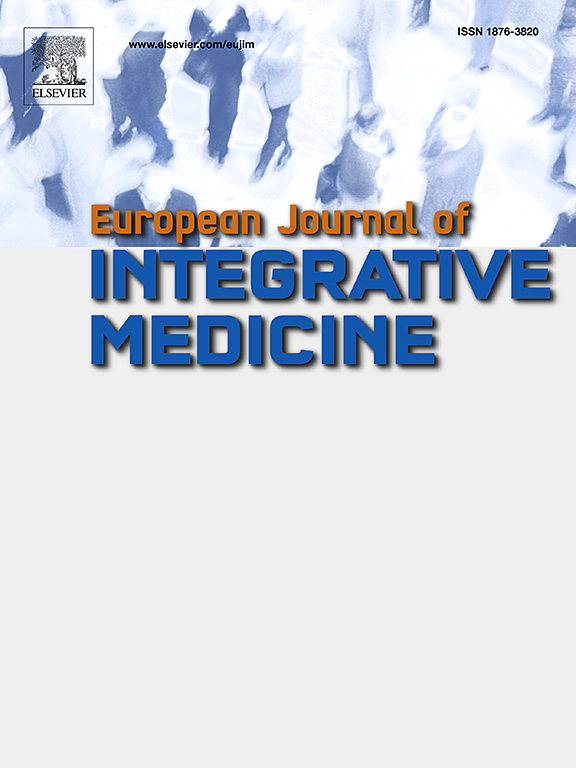针灸治疗慢性癌症疼痛:系统回顾和荟萃分析
IF 1.7
4区 医学
Q3 INTEGRATIVE & COMPLEMENTARY MEDICINE
引用次数: 0
摘要
疼痛在癌症患者中非常普遍。国际疾病分类第11版(ICD-11)将癌性疼痛分为慢性癌性疼痛(MG30.10)和慢性癌后治疗疼痛(MG30.11)。本研究旨在确定针灸治疗慢性癌性疼痛的有效性和安全性(MG30.10)。方法系统检索自建立至2024年12月31日的8个中英文数据库,以确定随机对照试验(rct),这些试验检验了针灸联合积极治疗与单独积极治疗(与治疗组相同)、不治疗或假针灸对癌症疼痛管理的疗效。使用Cochrane风险偏倚工具(ROB 2.0)评估偏倚风险,使用RevMan 5.4和Stata 17.0进行数据分析。此外,使用推荐评估、发展和评价分级(GRADE)方法评估证据质量。结果meta分析共纳入21项rct,共纳入1432例患者。meta分析显示,与对照组相比,治疗组表现出显著降低的数值评定量表(NRS)评分(平均差值(MD) = -0.93, 95%可信区间(CI) [-1.21, -0.64], P<0.00001,低确定性),更少的突发疼痛事件(MD = -2.13, 95% CI [-2.86, -1.39], P<;0.00001,低确定性),镇痛药消耗减少(标准平均差(SMD) =-0.60, 95% CI [-0.84, -0.37], P<0.00001,中等确定性),生活质量改善(MD =6.37, 95% CI [3.21, 9.54], P<0.0001,低确定性),服用镇痛药的副作用减少,针灸治疗无严重不良反应。结论针刺与镇痛药物结合治疗慢性癌性疼痛具有显著缓解疼痛和改善镇痛药物不良反应的潜力(MG30.11)。然而,需要进一步的高质量随机对照试验来阐明针灸在癌症疼痛管理中的功效并优化治疗方案。RegistrationCRD42024550206本文章由计算机程序翻译,如有差异,请以英文原文为准。
Acupuncture for chronic cancer pain: a systematic review and meta-analysis
Introduction
Pain is highly prevalent among cancer patients. Cancer pain is classified as chronic cancer pain (MG30.10) and chronic post-cancer treatment pain (MG30.11) in the International Classification of Diseases, 11th Revision (ICD-11). This research aims to ascertain the efficacy and safety of acupuncture in treating chronic cancer pain (MG30.10).
Methods
Eight Chinese and English databases were systematically searched from their inception to December 31, 2024, to identify randomized controlled trials (RCTs) that examined the efficacy of acupuncture in combination with active treatments versus active treatment alone (identical to the treatment group), no treatment, or sham acupuncture for cancer pain management. The risk of bias was assessed using the version 2 of the Cochrane risk-of-bias tool (ROB 2.0), and data analysis was conducted utilizing RevMan 5.4 and Stata 17.0. Additionally, the quality of evidence was evaluated using the grading of recommendations assessment, development, and evaluation (GRADE) approach.
Results
A total of 21 RCTs were included in the meta-analysis, involving 1432 patients. The meta-analysis revealed that compared to the control group, the treatment group exhibited significantly reduced Numeric Rating Scales (NRS) scores (mean difference (MD) = -0.93, 95 % confidence interval (CI) [-1.21, -0.64], P<0.00001, low certainty), fewer burst pain events (MD = -2.13, 95 % CI [-2.86, -1.39], P < 0.00001, low certainty), reduced analgesic consumption (standard mean difference (SMD) =-0.60, 95 % CI [-0.84, -0.37], P<0.00001, moderate certainty), improved quality of life (MD =6.37, 95 % CI [3.21, 9.54], P<0.0001, low certainty), and diminished side effects of taking analgesics, with no serious adverse effects of acupuncture treatment.
Conclusion
The integration of acupuncture with analgesic drugs has demonstrated considerable potential to significantly mitigate pain and ameliorate adverse effects of analgesics in patients with chronic cancer pain (MG30.11). However, further high-quality RCTs are required to elucidate the efficacy of acupuncture in cancer pain management and optimize treatment protocols.
Registration
CRD42024550206
求助全文
通过发布文献求助,成功后即可免费获取论文全文。
去求助
来源期刊

European Journal of Integrative Medicine
INTEGRATIVE & COMPLEMENTARY MEDICINE-
CiteScore
4.70
自引率
4.00%
发文量
102
审稿时长
33 days
期刊介绍:
The European Journal of Integrative Medicine (EuJIM) considers manuscripts from a wide range of complementary and integrative health care disciplines, with a particular focus on whole systems approaches, public health, self management and traditional medical systems. The journal strives to connect conventional medicine and evidence based complementary medicine. We encourage submissions reporting research with relevance for integrative clinical practice and interprofessional education.
EuJIM aims to be of interest to both conventional and integrative audiences, including healthcare practitioners, researchers, health care organisations, educationalists, and all those who seek objective and critical information on integrative medicine. To achieve this aim EuJIM provides an innovative international and interdisciplinary platform linking researchers and clinicians.
The journal focuses primarily on original research articles including systematic reviews, randomized controlled trials, other clinical studies, qualitative, observational and epidemiological studies. In addition we welcome short reviews, opinion articles and contributions relating to health services and policy, health economics and psychology.
 求助内容:
求助内容: 应助结果提醒方式:
应助结果提醒方式:


